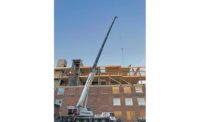In Massachusetts, the MEMA spokesman says most of the collapses have occurred inside I-495 in the Boston metro area. “I am unaware of any deaths within commercial buildings, although there have been a few shovelers who have either fallen off a roof or gone through a skylight. A majority are flat-roof commercial buildings or barns.”
“Most years, we see few, if any, roof collapses and do not have the repetitive storms without a thaw in between,” he adds. However, 2011 had similar conditions, with more than 300 roof collapses.
The crippling snowfall on Feb. 17 caused the failure of part of a pressurized sewer system on Plum Island on Boston’s North Shore, according to MEMA. The town of Newburyport reported that about 150 homes had experienced water-related issues and sewage backup due to blocked vents and frozen sewer-system valves.
Steve Bowen, associate director at Impact Forecasting, a London-based catastrophe model development center within reinsurer Aon Benfield, says, “Given the significant amount of snow that has fallen across southern New England, most notably in greater Boston, it will take weeks or months to fully gauge the scope of snow and ice damage. Based on initial estimates of storm costs, business interruption, and early damage tallies from state and local officials, it is expected that we are now north of $1 billion when aggregating losses from all of the storms.”
Dominic Kelly, principal at Waltham, Mass.-based Simpson, Gumpertz & Heger, says that, as of Feb. 25, the SGH office has 100 open projects, two-thirds of which are to assess the safety of structures and whether to remove snow. That compares to a total of 100 projects for the entire winter of 2011.
While a majority of the projects involve roofs, SGH also is assessing some cases in which plows have pushed snow into the side of a building or snow has slid down from an upper level, creating lateral pressure on walls.
“Snow loads have varied a small amount over time, but current building codes in Massachusetts and much of the Northeast are adequate to support current snow loads,” Kelly says.
“Structures most impacted by snow loads are older buildings with lightweight roof structures and configurations that lead to snow drifts, unbalanced snow and sliding snow for which they are not designed,” he says.
In Maine and Vermont, where snowfall is typically greater than in southern New England, state agencies have been fortunate.
“We haven’t gotten any reports so far,” says a spokeswoman for Maine Emergency Management. “The snow this past week was a lot heavier, but lots of people were out clearing their roofs, and crews were shoveling hospitals and school roofs,” she said.


